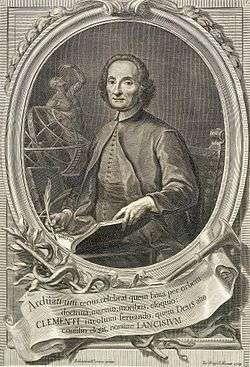Giovanni Maria Lancisi
| Giovanni Maria Lancisi | |
|---|---|
 Giovanni Maria Lancisi | |
| Born |
26 October 1654 Rome |
| Died |
20 January 1720 (aged 65) Rome |
| Nationality | Italy |
| Alma mater | University of Rome |
| Known for |
malaria cardiovascular diseases |
| Scientific career | |
| Fields |
medicine anatomy |
Giovanni Maria Lancisi (26 October 1654 – 20 January 1720) was an Italian physician, epidemiologist and anatomist who made a correlation between the presence of mosquitoes and the prevalence of malaria. He was also known for his studies about cardiovascular diseases, and is remembered in the eponymous Lancisi's sign.
Biography
Giovanni Maria Lancisi (Latin name: Johannes Maria Lancisius) was educated at the Collegio Romano and the University of Rome, where he qualified in medicine aged 18. He was physician to Popes Innocent XI, Clement XI and Innocent XII. He was given the lost anatomical plates of Bartolomeo Eustachius by Pope Clement XI; these were made in 1562 and had been forgotten in the Vatican Library. Lancisi edited and published them in 1714 as the Tabulae anatomicae.[1] He studied epidemiology, describing malaria and influenza epidemics. He published De Noxiis Paludum Effluviis (On the Noxious Effluvia of Marshes) in 1717, in which he recognized that mosquito-infested swamps are the breeding ground for malaria and recommended drainage of these areas to prevent it. He also published extensively on cardiology, describing vegetations on heart valves, cardiac syphilis, aneurysms and the classification of heart disease. His landmark De Motu Cordis et Aneurysmatibus was published posthumously in 1728.[2]
Early in the 18th century, Lancisi had protested the medieval approaches to containing rinderpest in cattle by famously stating that "it is better to kill all sick and suspect animals, instead of allowing the disease to spread in order to have enough time and the honour to discover a specific treatment that is often searched for without any success" (Mantovani and Zanetti, 1993). It was no wonder then, that it was the same Giovanni Maria Lancisi who made the first breakthrough in the control of rinderpest (Lancisi, 1715), a procedure that was later adopted by Thomas Bates (Bates, 1718).
Brain & Soul Inquiries
Lancisi described the corpus callosum as the "seat of the soul, which imagines, deliberates and judges."[3] His Dissertatio Physiognomica provided the supporting argument in 1713. He opposed alternative locations of the soul as hypothesized by others, such as the centrum ovale, by Andreas Vesalius, and the pineal gland, by René Descartes. He hypothesized that the Longitudinal striae (later named in his honor as the "striae lancisi" or "nerves of Lancisi") were the conduit between the anterior location of the soul, and the posterior location of sensory organ functions, both within the corpus callosum.[4]
Notes
- ↑ Firkin, Barry G.; Whitworth, Judith A. (1996). Dictionary of Medical Eponyms (2nd ed.). Parthenon. p. 225. ISBN 1-85070-477-5.
- ↑ Giovanni Maria Lancisi at TheFreeDictionary.com
- ↑ Andrew P. Wickens, A History of the Brain: from Stone Age Surgery to Modern Neuroscience (2014)
- ↑ Marco Catani, Stefano Sandrone, Brain Renaissance: From Vesalius to Modern Neuroscience (2015) p. 85.
References
- Gazzaniga, Valentina (2003). "Giovanni Maria Lancisi and urology in Rome in early modern age". J. Nephrol. 16 (6): 939–44. PMID 14736023.
- Mantovani, A; Zanetti R (1993). "Giovanni Maria Lancisi: De bovilla peste and stamping out". Historia medicinae veterinariae. 18 (4): 97–110. PMID 11639894.
- Fye, W B (1990). "Giovanni Maria Lancisi, 1654–1720". Clinical cardiology. 13 (9): 670–1. doi:10.1002/clc.4960130917. PMID 2208828.
- McDougall, J I; Michaels L (1972). "Cardiovascular causes of sudden death in "De Subitaneis Mortibus" by Giovanni Maria Lancisi. A translation from the original latin". Bulletin of the history of medicine. 46 (5): 486–94. PMID 4570450.
- Michaels, L (February 1972). "Pain of cardiovascular origin in the writings of Giovanni Maria Lancisi". Canadian Medical Association Journal. 106 (4): 371–3. PMC 1940389. PMID 5061134.
- "GIOVANNI MARIA LANCISI (1654–1720)--CARDIOLOGIST, FORENSIC PHYSICIAN, EPIDEMIOLOGIST". Journal of the American Medical Association. 189: 375–6. August 1964. doi:10.1001/jama.1964.03070050041016. PMID 14160512.
- Pazzini, A (April 1954). "[To Giovanni Maria Lancisi on three hundredth anniversary of his birth.]". Athena; rassegna mensile di biologia, clinica e terapia. 20 (4): 177–80. PMID 13181790.
External links
| Wikimedia Commons has media related to Giovanni Maria Lancisi. |
- (in Latin) Dissertatio historica de bovilla peste, ex Campaniae finibus anno 1713, Rome, 1715.